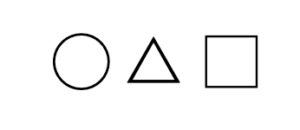Kakejiku: Three Forms

Kake-mono, 掛物, hang-thing; calligraphy, En–sō, 円相, Circle-aspect, ‘Byō-jō-shin Kore-dō’, 平常心是道, Level-ever-mind/heart is way.
Calligraphy by Yama-da Hō-in, 山田法胤 Mountain-field Law-descendant, abbot of Yaku-shi-ji, 薬師寺, Medicine-master-temple, Na–ra, 奈良, What-good: L. 5.5 shaku kane-jaku.
The phrase beneath the ensō is inspired by the Zen teaching story wherein the monk, Jō-shū, 趙州, Hasten-state, asked priest, Nan-sen, 南泉, South-spring, how to attain enlightenment, Nansen replied ‘Ordinary heart is the way’.
A hanging scroll, kake-jiku, 掛軸, is attached to a half-round wooden dowel, hyō-moku, 表木, surface-wood, which has the shape described as either han-getsu, 半月, half-moon, or ha-ssō, 八双, eight-pair. Prior to the middle Edo period, the hyōmoku was often triangular, hence, the Kanji, 八, is used for its visual form. This Kanji resembles a mountain, and/or the felicitous sue-hiro, 末広, ends-wide, symbolic of Infinity in Space.
The upper area of the standard kakejiku, is identified with heaven, ten, 天, the lowest area is identified with earth, chi, 地. Continuing with an analogy, the ‘mountain’ is above heaven. The principal dowel of the scroll is the jiku, 軸, which is necessarily round so that the scroll won’t be damaged or folded. The circular ends of the jiku/dowel are likened to the sun. In this circumstance, with the sun below the moon, there is the suggestion that the scroll is associated with the night.

Connecting the shapes of circle, triangle and the straight edge, the scroll itself is a rectangle, so that when the scroll presents the three basic shapes of existence.
For further study, see also: Furo Ro: Three Forms, Dragon in Chanoyu, and Tokonoma and Imae

